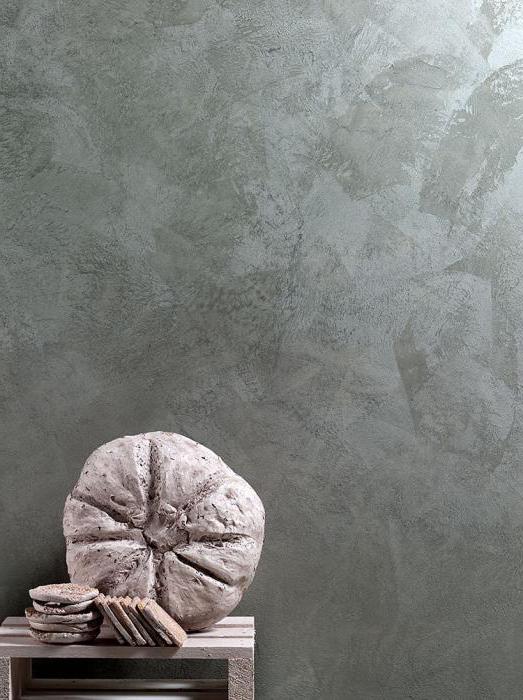Painting is considered a simple, easy and popular way of wall decoration, which is available to almost everyone. The range of modern paints and varnishes allows you to implement unusual and interesting ideas in the design.
Types of decorative paint for walls
There are two main groups of colors.
- For outdoor use. If necessary, they can be used indoors.
- For interior decorating.
In addition, depending on the film-forming substance, the paints are divided into:
- oil;
- enamel;
- glue;
- water emulsion.
Enamel and oil paints are also called alkyd.
Alkyd paints
Such paints are used for both exterior and interior decoration. They are water and light resistant, however, are not resistant to alkali and are fire hazard. Designed for painting plastered, wood and metal surfaces. They are applied with a spray gun, roller or brush. Diluted with turpentine and drying oil - oil paints, with special solvents and white spirit - enamel. Decorative alkyd paint for walls is applied in a well-ventilated area. It has a long drying time.
Adhesive paints
Based on aqueous solutions of cellulose ethers, polyvinyl alcohol, casein, starch, etc. By application and properties, decorative adhesive for walls is close to emulsion. An important plus of such paints is their porosity: moisture evaporates quickly through them, coatings from them do not interfere with air exchange.
Water-based and emulsion paints
This is a paint in which the binder base and pigments are dispersed in an aqueous medium, forming a stable suspension. After applying it to the surface, water begins to evaporate and the polymer film hardens. Therefore, such a decorative paint for walls is not afraid of the influence of water. Water based paints are non-toxic and fireproof. They do not exfoliate and maintain a healthy microclimate in the house.
Emulsion paints are used for painting plastered, primed, concrete, wood and metal surfaces, however, they are not suitable for varnished and adhesive surfaces. They perfectly fit on most coatings and are easily washed off from tools and hands. Apply them with a spray gun, roller and brush.
Water-based paints are divided into:
- polyvinyl acetate;
- latex;
- silicone;
- acrylic;
- silicate;
- mineral.
Polyvinyl acetate paints
Relate to the cheapest paints, but have poor resistance to wet cleaning and abrasion. They are mainly used for dry surfaces. Also a minus is considered a meager selection of colors for tinting, carried out only by hand.
Acrylic paints
These are the most popular paints made on the basis of acrylic resins. They have high elasticity and strength. They are not afraid of wet cleaning, they have a fairly good resistance to abrasion. However, acrylic decorative paint for walls should not be used in places where water can get on it. There are many colors for tinting acrylic paints, while tinting is done manually and using computerized tinting systems.
Latex paint
They have increased resistance to wet abrasion, they allow you to get a silky matte surface and cover the base with a thin layer. These are the most expensive water-based paints.
Silicate paint
It is an aqueous solution of water glass, miscible with colored pigments. With many surfaces, these paints are fused, forming strong physico-chemical bonds that are resistant to various atmospheric phenomena. Surfaces coated with silicate paints have high vapor and air permeability. They serve up to 20 years. Designed for decoration of internal and external walls and protection of wood structures from fire.
Silicone paints
Their basis is an aqueous dispersion of silicone resins. They are vapor permeable, have high elasticity, and are hygienic.
How to apply decorative paint on walls
Walls for various paints are prepared in different ways. They are cleaned of impurities and residues of old coatings. The degree of wall adhesion affects the need for abrasive treatment or primers. The necessary tools and application features depend on the specific composition.
Decorative effects
Using decorative paints, you can create a variety of decorative effects.
- Mosaic (multicolor) surface. It is composed of several paints, of which one is the main, the rest - plastic additives. However, different colors are not mixed, creating a multi-color base.
- "Aged" surface. It looks different. Decorative paint for walls (see photo in the article) allows you to create surfaces that mimic antique walls - “cracked canvas”, walls with the remains of gilding, frayed wall surfaces.
- Metal surfaces. Decorative wall paint allows you to create unique futuristic interiors in high-tech style. That is why it is often used fragmentarily. As a rule, the tint palette includes copper, silver, gold, metallic.

- Silk surfaces. Silk decorative wall paint has become very popular today. Thanks to the addition of polymer pearly “sawdust”, you can create a silk effect on the wall. The composition of such a paint includes water, acrylic resin (as a binding component) and pigment. The surface on which the decorative paint for the walls with the silk effect is applied dries quickly and is not exposed to atmospheric effects.
- Natural surfaces. As a rule, they are created due to texture. This decorative wall paint (photo) may contain small natural particles of shells, pebbles, sand or other mineral additives. Depending on the chosen shade, the same texture can create different associations: a blizzard, the sea, a sand dune.
The choice of decorative paints is expanding every day, new effects are created, unusual and interesting textures appear. Using them, you can create various effects at home and realize almost any design fantasies and ideas.